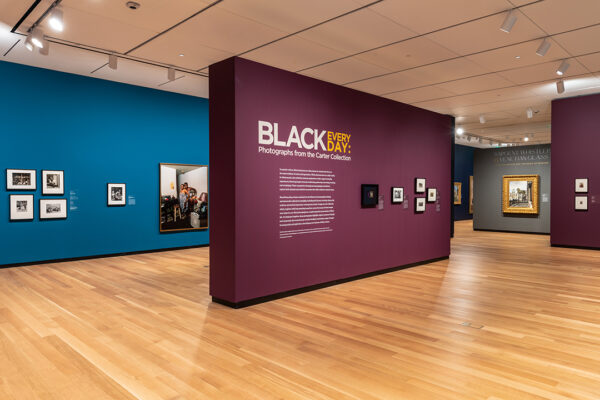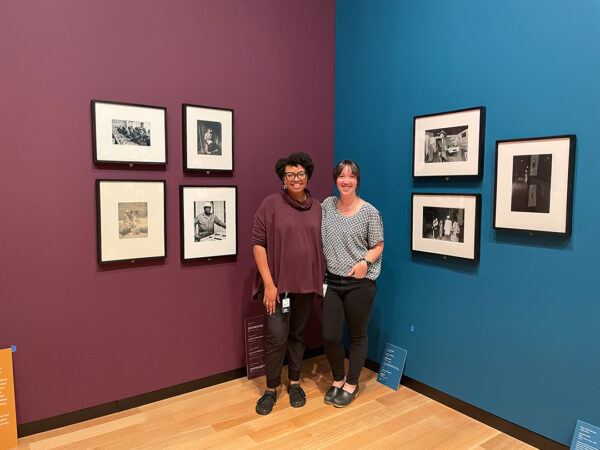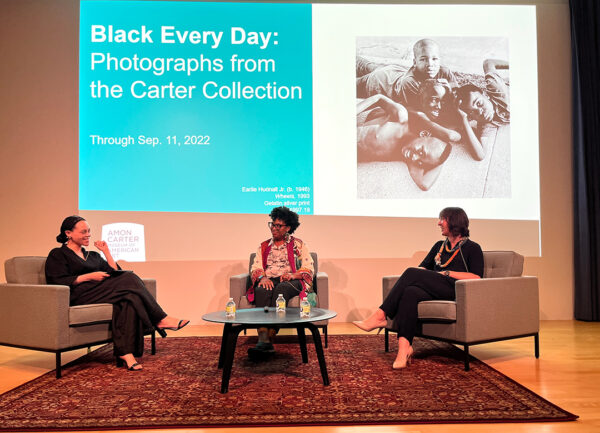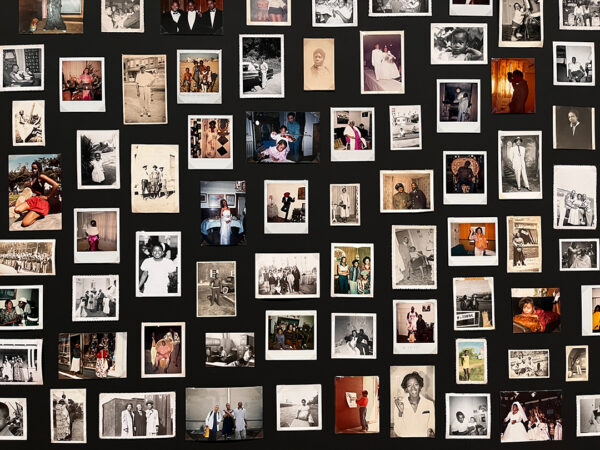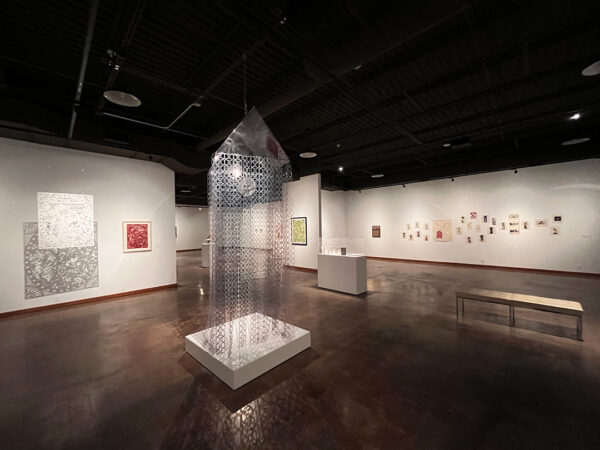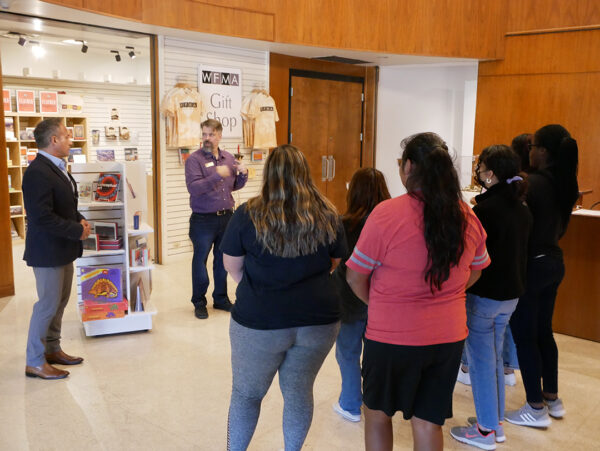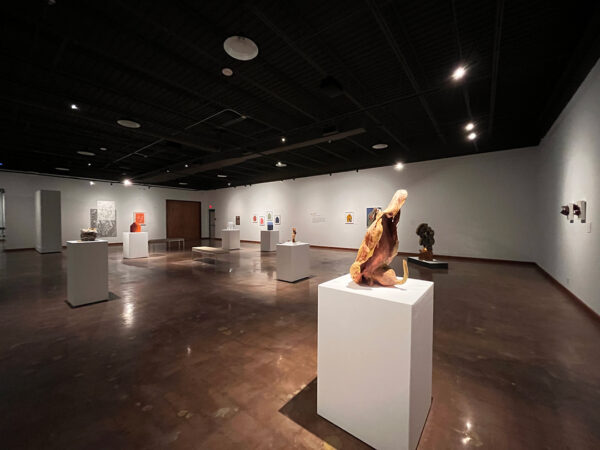Para leer este artículo en español, por favor vaya aquí. To read this article in Spanish, please go here.
Earlier this year, the Baltimore Museum of Art (BMA) presented the exhibition Guarding the Art, which featured pieces from the museum’s collection selected and arranged by guest curators from the museum’s security team. The concept was pitched by a BMA trustee who was considering ways the institution could better represent the diversity of the community it serves. Like this trustee, people who work in museums have come to realize that the security department may be the one group of staff members in an institution who spend the most face-to-face time with the art on the walls.
It is well documented that although the majority of staff at museums identify as white (non-Hispanic), security and facilities management departments comprise more non-white employees than the other departments, such as curatorial, education, exhibition design, and leadership. Asma Naeem, BMA’s Chief Curator, told CNN that working with the guards to curate this exhibition posed important questions like, “Who is art for? Who are museums for? Who gets to talk about the arts? Who holds the knowledge? Are there other kinds of people who have knowledge about art that we want to be hearing from?”
While these types of questions are important, they are not new. For the past few decades, museums have been ruminating on issues around access and have made strides to incorporate a variety of outside perspectives. In her 2010 book The Participatory Museum, Nina Simon, former Executive Director of the Santa Cruz Museum of Art & History, wrote about the importance of collaborating and co-creating with people and groups outside of the traditional museum structure. Similarly, in Contesting Knowledge: Museums and Indigenous Perspectives, a 2009 book edited by Susan Sleeper-Smith, Jacki Rand (an associate professor of American Indian Studies at the University of Illinois at Urbana-Champaign) writes about how in the mid-1900s museums began to seek out consultation from Indigenous people regarding the presentation of Native American art and artifacts.
Since many museums in the U.S. are historically and predominantly white institutions, it is necessary that they seek out people with perspectives and expertise outside that of the typical museum curator. Two current examples of these types of collaboratively organized exhibitions in Texas are Black Every Day at the Amon Carter Museum of American Art in Fort Worth and Finding Your Voice: Café Con Leche Co-Curates at the Wichita Falls Museum of Art at Midwestern State University.
During the summer of 2020, when the world was in the throes of the COVID-19 pandemic and people across the country were protesting police violence against Black people, many in the art world were reflecting on the ramifications of systemic racism in arts organizations. Kristen Gaylord, Associate Curator of Photographs at the Carter, noted that Black activists, cultural workers, and others were calling out the impact of the mainstream media’s focus on trauma when depicting Black life. Gaylord said, “Author Jerry Craft has called this limited representation ‘history and misery.’ I wondered what would happen if we put together a show instead depicting the breadth and depth of Black life in this country, which assuredly contains trauma but contains so much more than that.”
This was the impetus for Black Every Day, a photo exhibition which would give a broader view of Black life in the U.S. Since Gaylord isn’t herself Black, she felt that she couldn’t curate this exhibition alone. In her exhibition proposal, which she submitted to museum leadership, she was clear that a co-curator would be “a key component” to this exhibition.
Regarding the need for a co-curator, Gaylord has said, “I am a photo historian and have deep knowledge of the Carter collection, which we built the show from. But I knew I needed someone to provide many other kinds of expertise for this project, including subject expertise in the area of Black studies, especially material culture and media/representation, and the lived expertise of what it means to be Black in this country, since I am not. I talked with colleagues in and outside of the museum, and one name kept being recommended: Dr. Lauren Cross!”
An artist, scholar, and independent curator, Cross first met Gaylord in 2018, when she was invited to be an inaugural Carter Community Artist. (Full disclosure: during my time as Manager of School and Community Programs at the Carter, I invited Cross and three other North Texas artists to be part of the inaugural class of Carter Community Artists.) Then, in 2019, the two got to know each other better when they served on a public art panel together. Of her previous experience with the Carter, Cross said, “I think because I had been a Carter Community Artist I came to the project with a deep sense of what was in the Carter’s collection, as well as a history of the Carter’s past exhibitions reflecting the Black experience. I knew that it was an opportunity to contribute a really important narrative about what was represented in the museum’s world-renown photography collection as it relates to the Black experience.”
Both Gaylord and Cross have co-curated exhibitions in the past, though their experiences have differed. While Gaylord has traditionally worked with museum colleagues to co-curate exhibitions, this marked the first time she worked with a co-curator outside of her institution. On the other hand, as an independent curator, Cross has worked with a variety of organizations and institutions in collaborative ways. She began her curatorial experience with a co-curated exhibition based on her documentary film The Skin Quilt Project. At the time, she was living in Boston, and she collaborated with Erica Licea-Kane, Gallery Director of the Towne Art Gallery at Wheelock College.
While co-curating can take a variety of forms and, from project to project, will have varying levels of involvement, both Gaylord and Cross acknowledged that they worked closely on all aspects of Black Every Day. During an exhibition talk at the Carter, Gaylord stated, “What I tried to do… was make her an absolute partner in everything that I would ever do for a show. All I did on my own was write the proposal and ask her to join. From then on, if she wanted to, every meeting, every logistical [decision], even if it was a boring or unfun thing, I wanted her to be involved.”
Together they built the checklist, wrote labels and exhibition text, chose wall colors, oversaw the installation, and more. Because of this extensive approach, the exhibition took a little under two years from inception to opening, which according to Gaylord is on the longer side of the time it generally takes to mount a collection-based show.
During the exhibition talk, Cross noted, “Co-curating with Kristen has been one of my favorites. That says a lot. She was very sensitive to [include me in the full process]… And what that did, it created an opportunity for me, if there was something that I felt like was not hitting right, I could mention it and she would say, ‘Well, if you don’t want it, then that’s it.’”
As someone who worked at the Carter for nearly three years and is familiar with the museum’s collection, I was happy to see some fan favorites included in the exhibition, like Roy DeCarava’s Coltrane and Elvin and Gordon Parks’ Red Jackson, with his Mother and Brother, Harlem, New York. But, I was also surprised by the sheer number of photographs I had not seen before which shed new light on the depth of the Carter’s holdings. Additionally, the sections that the curators developed for the show — community, excellence, labor, and vernacular photography — provided a new perspective on some pieces and created connections between works I had not considered before. For example, their inclusion of Danny Lyon’s Student Nonviolent Coordinating Committee (SNCC) Sit-in in the “labor” section of the show works to broaden our perception of Black labor. The narrative of Black labor, which historically tends to focus on physical forced work and demeaning roles, is in the midst of shifting to encompass the reality and complexity of what labor can mean and has meant over time.
From the photographs chosen and the categories they have been organized into, to the labels and wall text that provides necessary context and perspective, Black Every Day is incredibly intentional. While the curatorial voice feels cohesive and seamless, it is also clear that this show was informed by experts both in the subject matter and the medium. Together, Cross and Gaylord fully acknowledge the harsh realities of the treatment of Black people in the U.S., while maintaining a sense of celebration and joy, infusing the Carter’s collection with new life.
Like Gaylord, Danny Bills, Curator of Collections and Exhibitions at the Wichita Falls Museum of Art (WFMA), has co-curated shows with others in his own institution, but Finding Your Voice: Café Con Leche Co-Curates was the first time he worked with outside co-curators. However, unlike Gaylord, who worked with a seasoned independent curator, Bills worked with five college-bound high school students, who had no prior curatorial experience. The students were associated with the Wichita Falls organization Café Con Leche, which supports parents and their school-aged children in planning for post-secondary education.
The idea for the exhibition developed following a 2018 lecture by art collector Cheech Marin at the museum on the occasion of the exhibition Papel Chicano Dos: Works on Paper from the Collection of Cheech Marin. Among the attendees were nearly thirty Café Con Leche students, led by the organization’s founder, Gonzalo Robles. The students’ experience was so impactful that both Bills and Robles wanted to find a way to involve Café Con Leche students in selecting artists for a future exhibition.
To recruit students for the project, Bills and Robles made presentations at three Wichita Falls public high schools pitching the opportunity as both a cultural arts and vocational experience. The five students, América Benítez, Andrea Granados, Patricia Odjewuyi, Natalie Perez, and Nathalie Rodriguez, met weekly with Bills for seven months to develop the exhibition.
About her decision to commit to this project, Rodriguez said, “I originally decided to join Danny with the exhibition because I thought I would get to see famous pieces and artists. And in a way I did, it introduced me to so many talented artists and people that make the exhibition happen.”
Odjewuyi said, “I love art, but I mostly focused on how it looked instead of the meaning behind it, so I thought working on this project would give me a different perspective of art. I haven’t really been to a museum before I worked on this project, so I was able to learn more about them and I got to experience it as someone putting together an exhibit, but also viewing one too, which made me see art in a different way.”
Throughout the planning of the exhibition, the students were involved every step of the way, including artist selection, exhibition design, promotional aspects, and installation. Not only did the students help identify the exhibition title, but they also saw the opportunity to play with the title through its design, to highlight the phrase our voice inside the official title Finding Your Voice. Alongside traditional gallery text in the exhibition are quotes by the student curators; these call-outs are also titled Our Voice. In one of these, Benítez says, “I see the title as coming together but still being your own person: still relating to others but showing and making your own conclusions.”
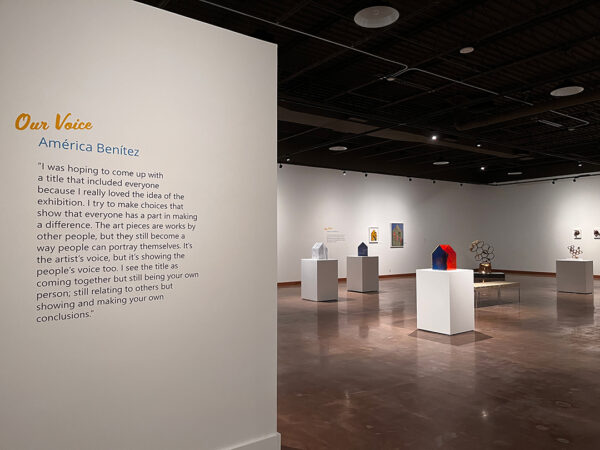
Installation image from “Finding Your Voice: Café Con Leche Co-Curates” at the Wichita Falls Museum of Art.
About co-curating with the students, Bills remarked that, “The process was refreshing because the students had no preconceived notions. Their ideas were fresh and outside of the usual curatorial box. The typical curation process for me would probably have a lot less compromise or a more task assigned workload. Each aspect of this exhibit was more of a shared approach with the group.”
All four artists in the show, three of whom are Houston-based and one of whom lives in Sweden, identify as Hispanic or Latino and were born in different Latin American countries. The artists include Gaby Berglund Cárdenas (Ecuador), Guadalupe Hernandez (Mexico), Lorena Morales (Venezuela), and Graciela Paz (Guatemala). In her Our Voice wall quote, student curator Perez remarks about the significance of this exhibition including not just Latino voices, but also Latina voices.
The introductory text at the beginning of the exhibition mentions that the themes present in the show reflect the student-curators’ lived experiences. As a Latina walking through the show, I felt a strong sense of connectivity to themes of home and storytelling, and was moved by the echoes of mediums that are deeply connected to Latino artistry, such as Hernandez’s papel picado works and Cárdenas’ woodcut prints on fabric. While the students’ perspectives clearly shaped the artist and artwork selection, the physical layout of the exhibition feels very traditional, with each artist generally relegated to their own space within the gallery.
Both student curators that I spoke with, Odjewuyi and Rodriguez, talked about how they were surprised by the amount of work and detail that goes into exhibition planning. While both indicated that they don’t currently have plans to go into the field of curation, they have certainly gained a new understanding of museum work and collaborative processes.
While co-curating with people outside of an institution is not always practical or necessary for every exhibition or situation, it is exciting to see museum curators across Texas bring in guest curators, artists, and community members to help broaden their institutions’ narratives. Sharing authority with people who haven’t historically been in positions of power and highlighting perspectives that are often absent from predominantly white institutions are both effective ways to build relevance and a sense of belonging for museum visitors. As the demographics of the U.S. continue to shift, with people of color estimated to hold the majority by 2045, predominantly white institutions must make sweeping changes in order to maintain relevance and keep up with the times. While overarching, years-long change will involve museums hiring (and retaining) people of color to all departments and leadership positions, improving at reflecting diverse perspectives and expertise, and acquiring and presenting more works of art by artists of color, exhibitions like these at the Carter and the Wichita Falls Museum are a good start.


